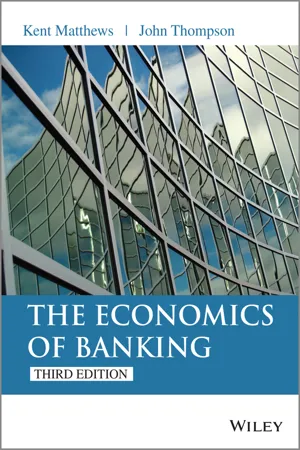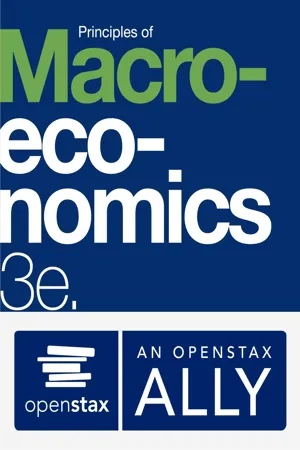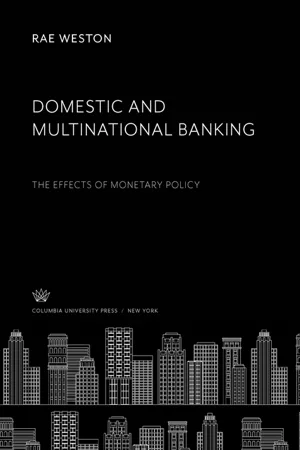Economics
Banking
Banking refers to the industry and practice of accepting deposits, lending money, and providing financial services. Banks play a crucial role in the economy by facilitating the flow of funds between savers and borrowers, and by offering various financial products such as loans, mortgages, and investment services. The banking sector is regulated to ensure stability and protect consumers.
Written by Perlego with AI-assistance
Related key terms
1 of 5
4 Key excerpts on "Banking"
- eBook - PDF
- S. Janssen(Author)
- 2009(Publication Date)
- Palgrave Macmillan(Publisher)
8 2 What Is a Bank? 2.1 Introduction Without discussing the theoretical question of what constitutes a financial intermediary at great length, this book accepts that there are financial inter- mediaries, such as banks, insurance companies and investment companies which are instrumental to the functioning of the financial markets as their activities provide the institutional framework. Clearly, there would not be any significant financial market without these financial institutions, nei- ther would there be any financial institution without the existence of such markets. The structure of a financial system is to a great extent contingent upon the institutions that make up the system. Unlike insurance and investment companies, banks play the most important role in maintaining the stability of a financial system. Therefore, this work focuses on banks, which makes it necessary to consider the definition of a “bank”. This can be approached in a threefold manner (Büschgen, 1993, pp. 9–26). Büschgen differentiates between a legal, a microeconomic and a macroeconomic definition of a bank – an approach that also appears functional for this book. Consequently, this chapter first provides an overview of the bank-specific directives adopted at EU level, and then outlines the legal definitions of a bank in the United Kingdom and Germany. The second half of this chapter considers the microeconomic definition of a bank, and concludes with the inextricably linked macroeconomic concept of a bank. 2.2 The rationale for Banking regulation Prior to the discussion of a bank’s legal status in the EU, the United Kingdom and Germany, it is necessary to explain why the Banking sector is so heavily regulated. The banks’ pivotal role within the financial system essentially stems from their transformation function, which implies the matching of monetary surplus and deficit units (Mishkin, 1986; Howells & Bain, 2002). - eBook - PDF
- Kent Matthews, John Thompson(Authors)
- 2014(Publication Date)
- Wiley(Publisher)
CHAPTER 3 Banks and Financial Intermediation MINI-CONTENTS 3.1 INTRODUCTION 3.2 DIFFERENT REQUIREMENTS OF BORROWERS AND LENDERS 3.3 TRANSACTION COSTS 3.4 LIQUIDITY INSURANCE 3.5 ASYMMETRY OF INFORMATION 3.6 OPERATION OF THE PAYMENTS MECHANISM 3.7 DIRECT BORROWING FROM THE CAPITAL MARKET 3.8 CONCLUSION 3.9 SUMMARY 3.1 INTRODUCTION In this chapter we examine the role of financial intermediation in general and banks in particular. Financial intermediation refers to borrowing by deficit units from financial institutions rather than directly from the surplus units themselves. Hence, financial interme- diation is a process that involves surplus units depositing funds with financial institutions that in turn lend to deficit units. This is illustrated in Figure 3.1. In fact, the major external source of finance for individuals and firms comes from financial intermediaries – Mayer (1990) reports that over 50% of external funds to firms in the USA, Japan, the UK, Germany and France were provided by financial intermediaries. Financial intermediaries 1 can be distinguished by four criteria: 1. Their liabilities, i.e. deposits, are specified for a fixed sum that is not related to the performance of their portfolio. 1 They are now described as Monetary Financial Institutions in statistics produced by the Bank of England. 2. Their deposits are of a short-term nature and always of a much shorter term than their assets. 3. A high proportion of their liabilities are chequeable. 4. Neither their liabilities nor their assets are in the main transferable. This aspect must be qualified by the existence of certificates of deposit (see Chapter 4 for a description of these assets) and securitization (see Chapter 9 for a full discussion of securitization). At the outset it is useful to make the distinction between financial intermediaries who accept deposits and make loans directly to borrowers and those who lend via the purchase of securities. - eBook - PDF
- David Shapiro, Daniel MacDonald, Steven A. Greenlaw(Authors)
- 2022(Publication Date)
- Openstax(Publisher)
He answered: “That’s where the money is.” While this may have been true at one time, from the perspective of modern economists, Sutton is both right and wrong. He is wrong because the overwhelming majority of money in the economy is not in the form of currency sitting in vaults or drawers at banks, waiting for a robber to appear. Most money is in the form of bank accounts, which exist only as electronic records on computers. From a broader perspective, however, the bank robber was more right than he may have known. Banking is intimately interconnected with money and consequently, with the broader economy. Banks make it far easier for a complex economy to carry out the extraordinary range of transactions that occur in goods, labor, and financial capital markets. Imagine for a moment what the economy would be like if everybody had to make all payments in cash. When shopping for a large purchase or going on vacation you might need to carry hundreds of dollars in a pocket or purse. Even small businesses would need stockpiles of cash to pay workers and to purchase supplies. A bank allows people and businesses to store this money in either a checking account or savings account, for example, and then withdraw this money as needed through the use of a direct withdrawal, writing a check, or using a debit card. Banks are a critical intermediary in what we call the payment system, which helps an economy exchange goods and services for money or other financial assets. Also, those with extra money that they would like to save can store their money in a bank rather than look for an individual who is willing to borrow it from them and then repay them at a later date. Those who want to borrow money can go directly to a bank rather than trying to find someone to lend them cash. Transaction costs are the costs associated with finding a lender or a borrower for this money. - eBook - PDF
Domestic and Multinational Banking
The Effects of Monetary Policy
- Rae Weston(Author)
- 2019(Publication Date)
- Columbia University Press(Publisher)
Third, it may be considered that investment in securities is merely a specialisation in an area in which more complete information is available on which to assess risk and that this provides an investment of stable risk, although not of stable return, to complement investment in personal and business loans of stable return but less stable risk. The holding of some part of reserves in the form of cash rather than of securities accords with the need to hold sufficient cash to accom-modate the demands of customers and this amount may be minimised over time with greater experience of customer requirements. From this interpretation of Banking as the retailing of services it can be seen that the main activities of banks are readily explicable. It is further apparent that Camu's explanation of the nature of Banking fits neatly into this interpretation. Viewing Banking as a retailing of services does not, of course, move us away from analysing its operations by the use of the theory of the firm, it simply eschews the theory of produc-tion and portfolio theory as appropriate vehicles for analysis. Since a major concern of this study is the identification of the effects of regulation on Banking, in order to isolate and identify these effects it is necessary first of all to examine the operation of a Banking firm in an unregulated environment. The theory of the Banking firm developed in the remainder of this Part uses the diagrammatic approach as the most appropriate way of demonstrating the inherent interdependencies of Banking decisions. It is to the development of this model that we now turn. This does not of course mean that neither the theory of production nor portfolio theory is ever appropriate for the analysis of Banking.
Index pages curate the most relevant extracts from our library of academic textbooks. They’ve been created using an in-house natural language model (NLM), each adding context and meaning to key research topics.



